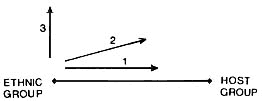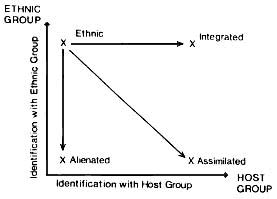Editor of this issue: Jonas Zdanys
Copyright © 1980 LITUANUS Foundation, Inc.

|
LITUANUS
LITHUANIAN QUARTERLY JOURNAL OF ARTS AND SCIENCES
Volume 26, No. 4 - Winter 1980
Editor of this issue: Jonas Zdanys ISSN 0024-5089
Copyright © 1980 LITUANUS Foundation, Inc. |

|
IMMIGRANT ADJUSTMENT: A NOTE ON KOVACS AND CROPLEY'S MODEL
ALDIS L. PUTNINŠ
Recently in the Australian Journal of Social Issues, Kovacs and Cropley have argued that previous considerations of cultural change in immigrants have unjustly neglected the role of alienation from the ethnic group, placing primary emphasis on assimilation to the host group.1 The underlying model which has led to the neglect of alienation is illustrated graphically in Figure 1 below.
fig. 1 THE UNIDIMENSIONAL MODEL

Ethnic and host groups are seen as lying at opposite ends of a single continuum. As an immigrant alienates from the ethnic group, he automatically assimilates to the host group, and vice versa. Thus, there is seen to be a perfect correspondence between alienation and assimilation, there being little importance in distinguishing the two since they are regarded as alternate views of the same phenomenon. Kovacs and Cropley diverge from this model. While agreeing that assimilation cannot occur without simultaneous and complementary alienation, they point out that alienation can occur without complementary assimilation; that is, an immigrant can estrange himself from his primary ethnic group without assimilating to some other. In this case there is an imbalance between the two processes and the immigrant finds himself in a state of alienation. Such a state is thought to be often found among immigrants and is invoked by the authors as an agent in the etiology of the various maladaptive behaviours observed more frequently in immigrant than host populations, such as suicide and psychopathologies. Kovacs and Cropley's underlying model can be described as the unidimensional model immersed in a sea of alienation, as indicated in Figure 2.
fig. 2 KOVACS AND CROPLEY'S MODEL

Various possible movements by an immigrant alienating from the ethnic group are illustrated by arrows 1, 2 and 3. Arrow 1 show what Kovacs and Cropley regard as the optimal direction for an immigrant adjusting to a new environment: alienation and assimilation are complementary, thus avoiding a state of alienation. Deviation from the optimum causes a state of alienation. Arrow 2 describes the case where, although an immigrant is closer to the host group than he was originally, alienation from the ethnic group has occurred with greater magnitude, thus to some degree producing a state of alienation. This, however, is not as extreme as that described by arrow 3, where alienation from the ethnic group has occurred without any assimilation or movement toward the host group.
The model implicitly proposed by Kovacs and Cropley is undoubtedly an improvement upon the unidimensional model. However, they have only partially freed themselves from the constraints of the latter. While acknowledging that alienation from the ethnic group can occur without corresponding assimilation to the host group, they none the less consider that assimilation is impossible without at least an equivalent amount of alienation.2 The latter proposition, however, is only true for some aspects of immigrant adjustment. In many areas, particularly those most important in defining ethnicity for the majority of European immigrant groups, such as language and ethnic identification,3 such a proposition is clearly false. An immigrant can learn to speak the host language fluently without in any way diminishing his competence in the ethnic tongue; thus he can assimilate in an important area and not lose any of his ethnicity. Similarly, just as an immigrant can alienate in terms of his self-identification from the ethnic group without assimilating to the host group, there is no logical reason which prevents identification with both host and immigrant groups simultaneously. This involves not just feeling half host and half ethnic, but to feel strong identification with both the ethnic and host groups (as a child may identify with both parents). Such a state is found most frequently in persons who emigrated at an early age or who were born to immigrant parents after their arrival in the host country. The model which more adequately describes these instances of immigrant adjustment is illustrated in Figure 3.
fig. 3 THE MULTI-DIMENSIONAL MODEL

As can be seen, the ethnic and host groups are placed on dimensions orthogonal to each other.4 While it still remains true that in many instances alienation and assimilation will tend to approximately equal each other, that is most persons will be found on or near the diagonal arrow, the model none the less allows for those cases where alienation and assimilation occur independently of each other, as in the case of highly alienated and highly integrated persons. The model can be expanded to include other dimensions, such as a second ethnic group or, since both ethnic and host groups are seldom completely homogeneous, subgroups within these groups. Furthermore, since the processes of adjustment by immigrants occur in a number of different areas which need not always be closely related to each other, to accurately describe an individual would require independently applying the above model to the various facets involved. The main distinction between the multi-dimensional model and the model employed by Kovacs and Cropley is that the former makes allowance for assimilation, at least in some areas, without the necessity of alienation. This point alone should surely be of considerable importance to those dealing with immigrants. It would appear that the pressures frequently exerted upon immigrants to give up their traditional ways, so as to be able to assimilate into the host group, may be unnecessary since it is possible to adopt at least some of. the host group characteristics without rejecting one's ethnicity.
REFERENCES
Editor's Note: This essay first appeared in the Australian Journal of Social Issues, Volume 11, Number 3, 1976, and is reprinted here with permission. The multidimensional model of immigrant adjustment is further discussed and elaborated in the author's forthcoming book, Latvians in Australia: Alienation and Assimilation, to be published by the Australian National University Press in Canberra.
1 Kovacs, M. L. and Cropley, A. J., Alienation and Assimilation of
Immigrants, Australian Journal of Social Issues 1975,10, 221-230. See also Kovacs,
M. L. and Cropley, A. J., Immigrants and Society: Alienation and Assimilation, Sydney:
McGraw-Hill, 1975.
2 Ibid., p. 117.
3 The importance of these two areas in defining ethnicity has also been pointed out in
Gubogolo, M. N., Socioethnic Consequences of Bilingualism, Soviet Sociology 1974,13,
93-113 (reprinted from Sovetskaia Etnografiia 1972).
4 This model has previously been employed in Penny, R., Aboriginal Drinking, paper
presented to the Fourth Annual Meeting of Australian Social Psychologists, Adelaide, 1975;
Putninš, A. L., Latviešu jaunatnes identifikacija (Identifications of Latvian
Youth), paper presented to the Third World Latvian Youth Congress, Florette, Belgium,
1975; Smolicz, J. J., Humanistic Sociology and the Study of Ethnic Cultures, paper
presented to the 46th ANZAAS Congress (Sociology Section), Canberra, 1975.